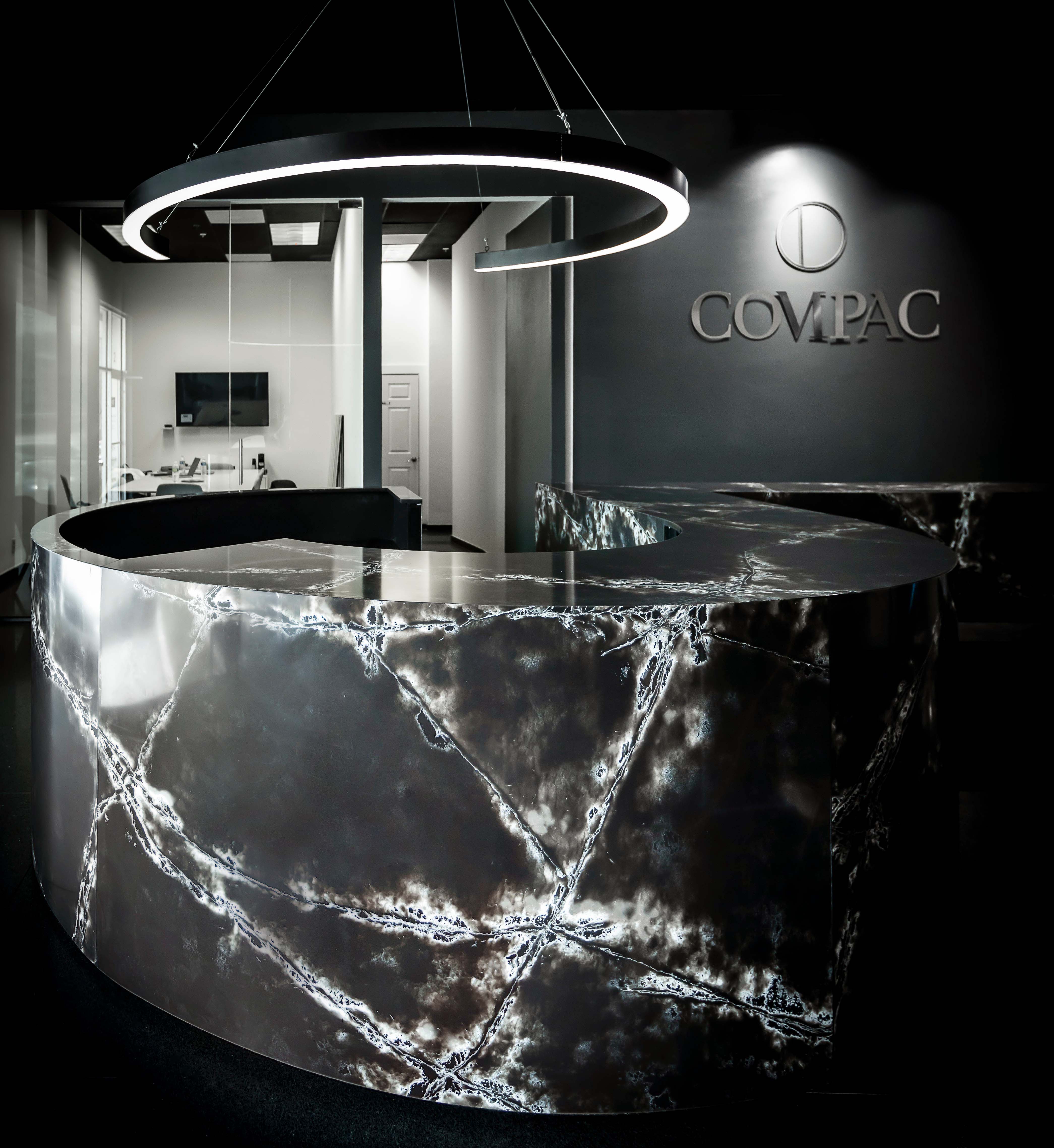Headquartered in Madrid, Ruiz-Larrea & Asociados architecture studio was established in 1997. The studio is a pioneer in developing bioclimatic architecture and home to a multidisciplinary team of partners and collaborators. Each of them take a cross-cutting approach to working with industry, with a strong commitment to research and constantly seeking new industrialised and sustainable solutions.
-
What are your references when designing architecture? Which past or present architect would you like to work with on a project?
Here at Ruiz-Larrea y Asociados we have recently been intrigued by the work of Lacaton & Vassal and architecture that seeks to solve major energy problems, drastically cutting costs through clear principles: ‘never demolish, eliminate or replace; always add, transform and reuse’. We are also drawn to Anna Heringer’s approach with its commitment to social, inclusive and gender-based sustainability. Along similar lines, we are interested in Peter Zhumthor’s artisanal work and use of light, Álvaro Siza’s simplicity and Aalvar Alto’s masterful human, nature-inspired architecture.
If I were to choose personal yardsticks, I would say the Spanish architects Higueras, Fisac, Carvajal, Cano Lasso, Moneo, etc. All of them worked in a highly difficult context with exceptionally meagre resources. Despite this, they showed immense ability in design, as well as maintaining an ethical commitment to improving people’s quality of life.
-
What do you believe most helped you to get where you are today? Would you have changed anything along the way?
Discipline, a commitment to the requirements of our clients and society, and a design approach that considers future building users. This is why we have developed three parallel work lines: teaching and research through our links to universities and companies in the sector; an intellectual perspective to produce a corpus of theory that sets out our vision through conferences and published works, and lastly, the designs themselves—a material expression of bioclimatic architecture that seeks maximum social, economic and environmental benefits.
If we could change anything, it would be having a greater ability to influence the commitment to research and real sustainability in architecture in Spain, not just to purely formal architecture. We would have liked to see the nation make a qualitative leap in these areas and move beyond short-term, commercial and speculative visions that have, at times, been prioritised. If this would have happened earlier, today we would be better prepared to face future challenges.
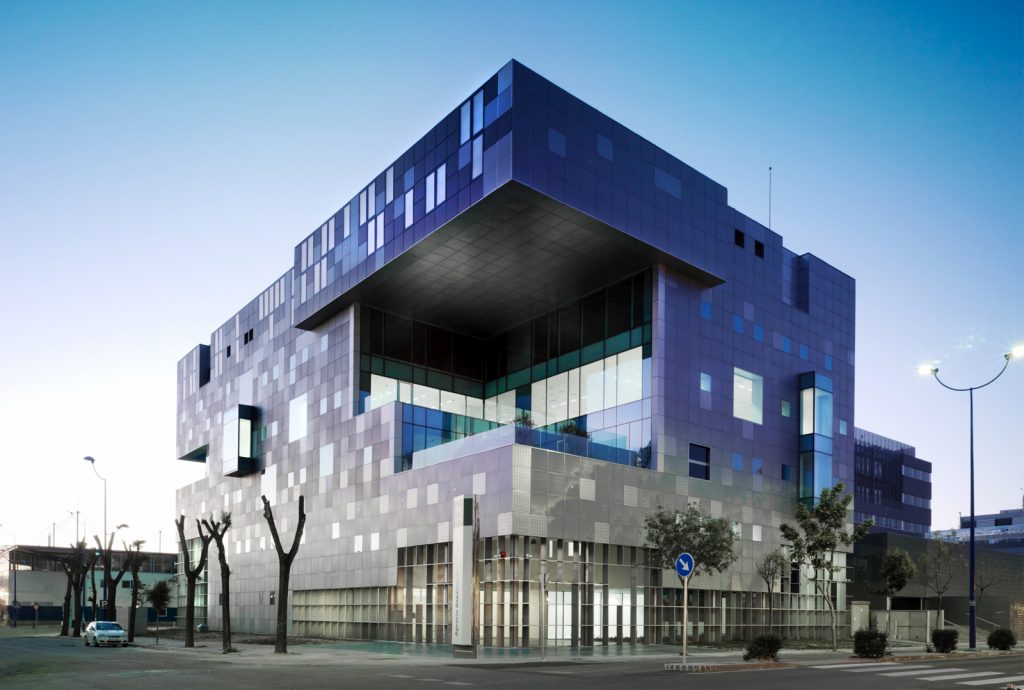
Andalusian Energy Agency. VIA Award for Sustainability and Honourable Mention at the Italian International Sustainable Architecture Awards. An example of a bioclimatic office building. Ruiz-Larrea y Asociados.
Which of your current projects would you highlight?
We work across all areas of architecture. However, the studio is highly committed at present to renovating standout buildings in Madrid. We are working for the Bank of Spain on the complete refurbishment of its Cibeles Tower site. And we’re also working on the headquarters of the Insurance Compensation Consortium in the former palace at Castellana 19. Moreover, we expect the new 5-star Madrid EDITION hotel to open to the public soon. Located in the heart of the old city, it is one of the most anticipated luxury hotel openings in the world for 2022. It has been a privilege to work in a well-established part of the city and improve the quality of the buildings there, through the latest advances in lowering energy requirements and instilling a commitment to the environment.
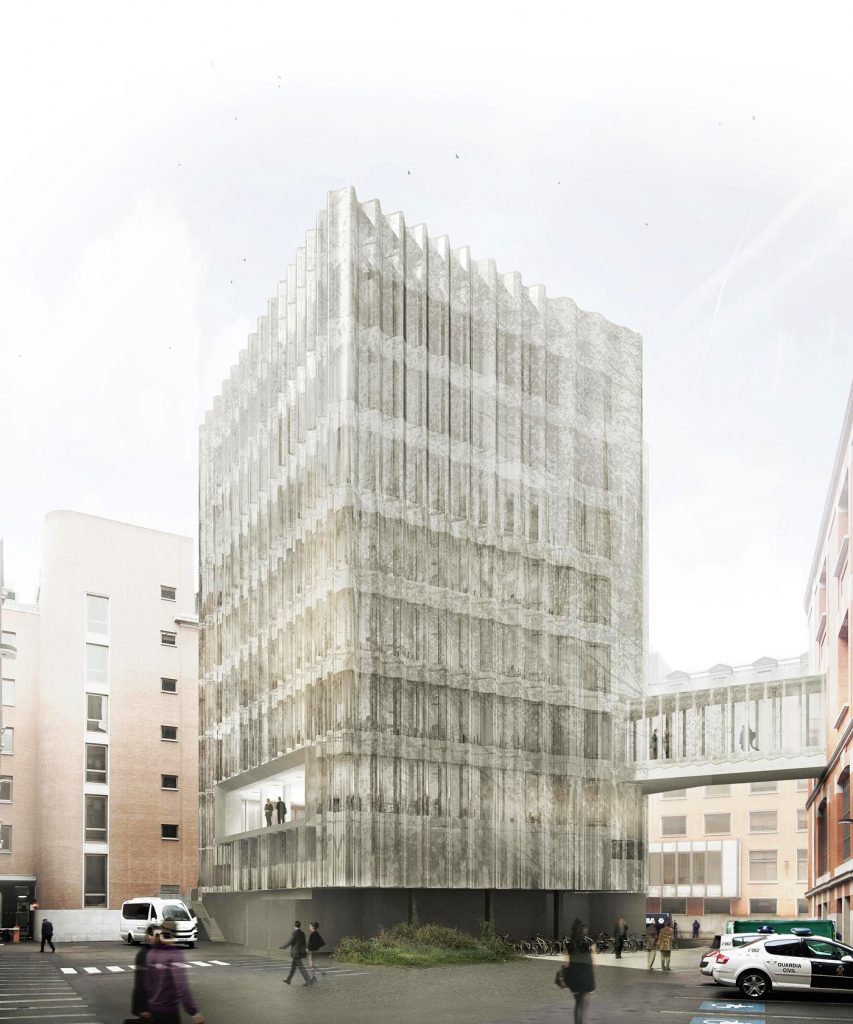
Bank of Spain. Winning project of the renovation competition. In progress. Ruiz-Larrea y Asociados.
On the teaching side, we have promoted a workshop at the University of Navarra—where I have lectured for many years—so that students get to design industrially constructed bioclimatic homes. In this sense, El Paso City Council (La Palma) will be able to provide a solution for those who were impacted by the volcanic eruption.
In our other area of activity, we are researching open industrialisation approaches to constructing on top of existing buildings that have not completely taken up their allocated planning permission for constructed surface area. The aim is to create highly efficient techniques at extremely reasonable prices. Techniques that can solve problems.
-
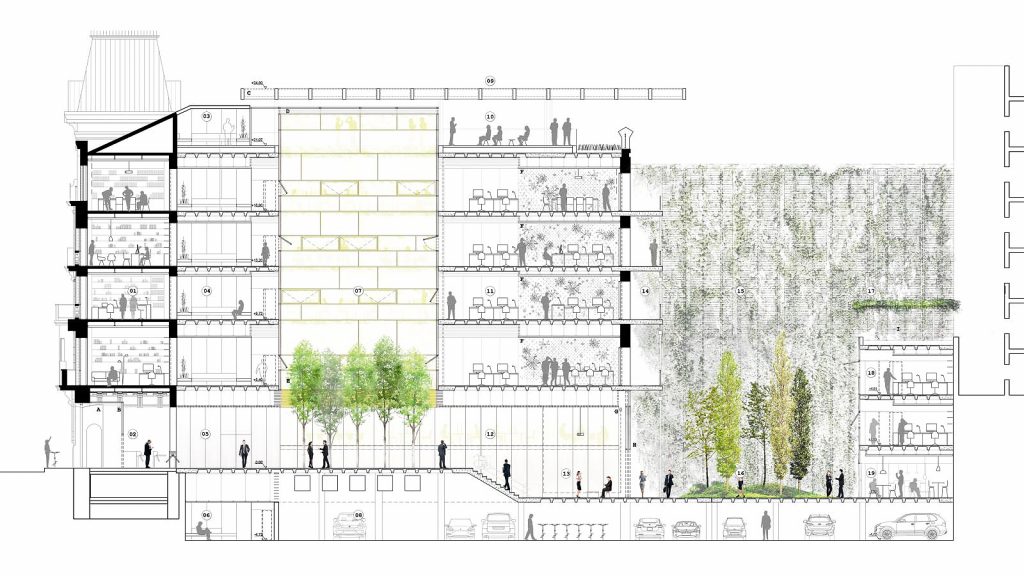
Castellana 19. Winning project of the renovation competition. In progress. Ruiz-Larrea y Asociados.
What would you say to young architects looking to work on a model like yours?
That they should discover bioclimatic architecture for what it is: a natural response to cut energy demand and consumption, achieve the necessary level of comfort and help in building maintenance at the design stage. In short, improve habitability and people’s quality of life. I would also recommend them to swiftly interiorise the idea that architecture is not an exclusive design process defined by formal abilities, as the old paradigm would dictate. Nowadays, architecture needs to provide a more cross-cutting, committed response.
Here at Ruiz-Larrea, we have spent decades working hand-in-hand with industry and investors to develop better solutions. The most successful projects have always come out of a three-way collaboration between our team, suppliers and clients. This involves constant, highly enriching dialogue with technical engineers, environmentalists, quantity surveyors, carpenters, gardeners, geologists, urban planners, etc,
-
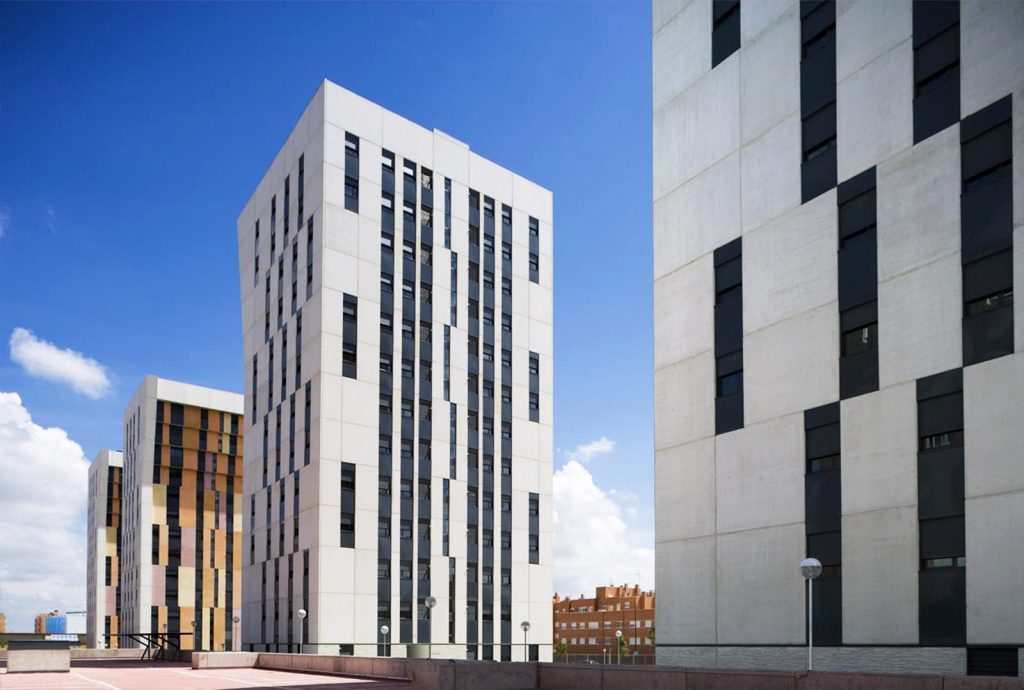
Torres Parla. Distinction at the 2009 COAM Awards. Another iconic public housing project built in line with bioclimatic criteria. Ruíz-Larrea y Asociados.
What is your dream project? How would you like to leave your mark on it?
In terms of project type, we would love to design a wooden skyscraper offering energy self-sufficiency and even energy production (a positive balance) thanks to a wider inclusion of available bioclimatic elements. Cities are a great human invention. However, they carry a heavy cost for society, the environment, the economy and personal relationships.
In this sense, we have also imagined a way to help in regenerating Spain’s depopulated areas with new collective models; by bringing together the huge advantages of cities, with the benefits of a more rural scale in terms of landscape, sustainability and quality of life. If places that have lost population could maintain a production system linked to the area and services that do not require proximity to a city, we could solve two of the greatest challenges of our lifetime: climate change and population decline. All this could be linked to a wider entrepreneurial culture in Spanish society in general.
-
What is your greatest source of inspiration?
Nature, without a doubt; understood as the search for a core balance between ecosystems. Until relatively recently, architecture merely consumed resources, transformed them and returned them as waste. We believe that the best architecture learns from nature. Using only the necessary resources and behaving like a living being by emulating nature. Bioclimatic architecture is capable of bringing together design, sustainability and immense quality. Ruiz-Larrea has spent 40 years using natural climate conditions to move towards near-zero consumption, generate minimum waste and provide our clients with exclusive innovative solutions, whilst making an ongoing contribution to the environment.
I’m not sure whether I will get to see it. But I do know that architectural designs that absorb CO2, generate oxygen and contribute to temperature regulation are just around the corner. They are sure to create comfortable conditions and achieve greater habitability in public spaces.
-
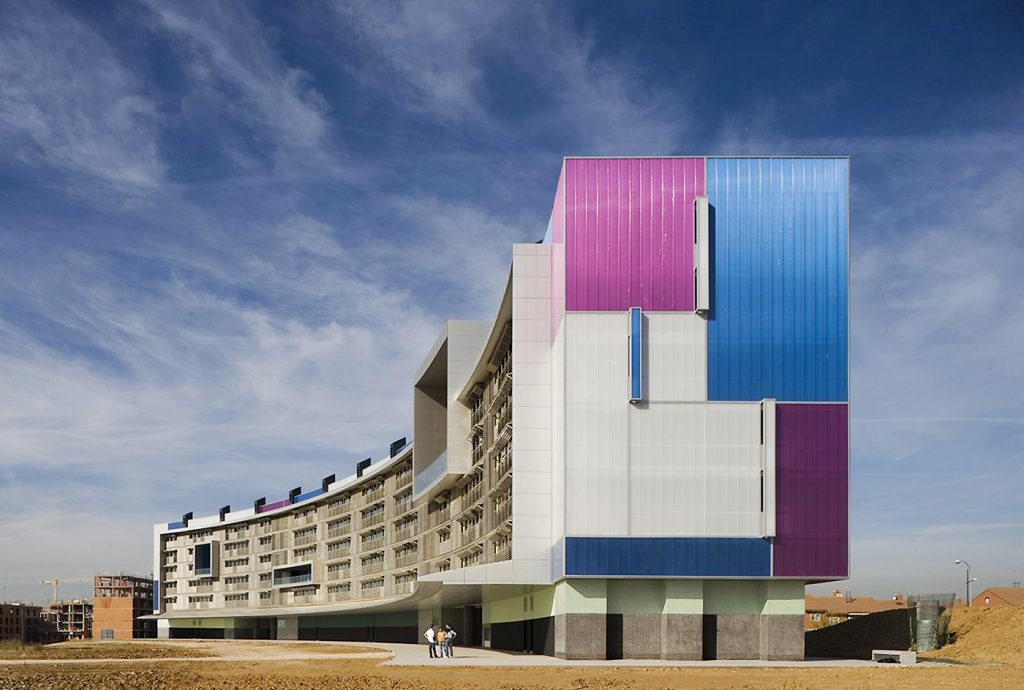
Solar Hemicycle. 2010 COAM Award. A pioneering bioclimatic public housing project in Móstoles. Ruiz-Larrea y Asociados.
Are you familiar with COMPAC materials? What advantages do you see in using stone for architecture projects?
Yes, we believe in the nobility and durability that stone can provide to a project. We have often used local or locally produced stone as a way to dialogue both typologically and formally with a project’s surrounding environment (Güímar Ethnographic Museum, ITER, Home in El Hierro). Using stone materials helps life cycles be more economical and sustainable, whilst also providing a sense of grandeur. We are less interested in materials that fail to contribute to social sustainability and the local economy. And less interested in those which are hugely expensive and generate large amounts of CO2 in production and transport. There are no good or bad materials, just materials that are used well or poorly.
-
What role would you say technology plays in your projects? Do you think it represents an advantage or a challenge? How would you like to include it in your projects?
We use technology as a support to cut back energy requirements as far as possible. Nonetheless, technology cannot replace good bioclimatic design which, in itself, is able to reduce energy needs in a building by over 60%. Nor do we believe in ‘hyper-technologisation’ as a substitute for good design. That approach is lazy and highly unsustainable in both economic and social terms. We support designs that first look at significant passive considerations and then use active technology to fulfil the demands that architecture has to respond to.
One trigger of the current environmental crisis is machine technology having evolved so much that it took on huge importance in architecture and, in the end, drove up final costs. Instead of concentrating on simple, natural and infinitely more economical solutions, the fervour for machines as a technological saviour for many purported utopias simply led to much higher energy consumption and maintenance costs. In short, we support rational and reasonable technology use. Anything else is unsustainable for companies, families and the planet as a whole.

